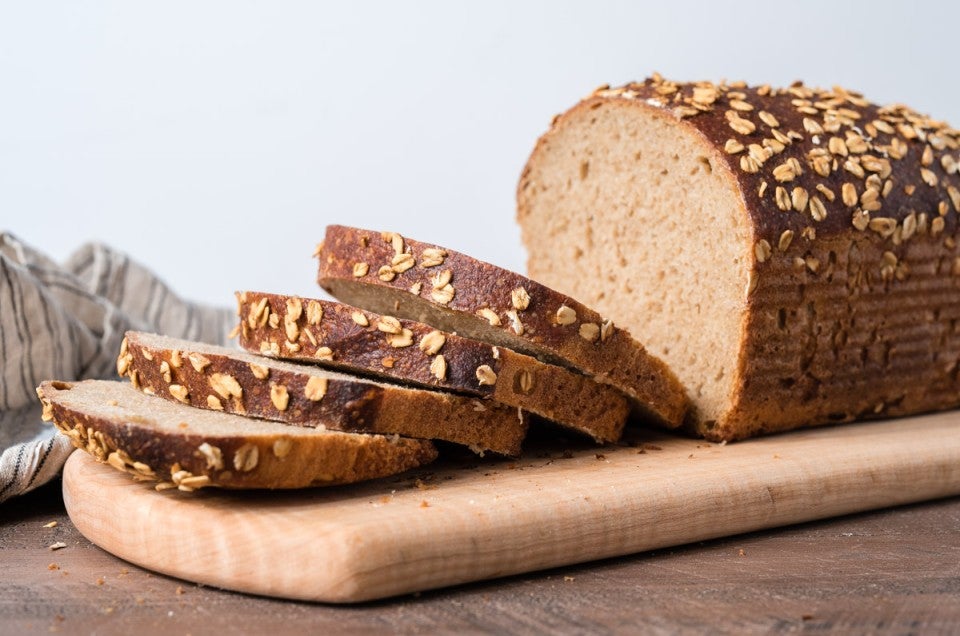


Artisan baker Maurizio Leo returns for his second blog post. Maurizio’s award-winning blog, The Perfect Loaf, is a beautifully photographed ode to baking naturally leavened sourdough. Check out his previous piece on Naturally Leavened Brioche-Style Kugelhopf.
Sliced sandwich bread was an undisputed staple of my childhood. Unfortunately, it's earned itself a fairly bad rap over the years. Most of us have come to associate the uniformly cut slices and stark white interior of the typical sandwich loaf with something mass produced and rushed; but perhaps we can help this often slighted bread by taking a different approach: a healthier one.
In this versatile Multigrain Sourdough Sandwich Bread the majority of the flour used is whole grain; the dough is completely naturally leavened; it has no additional sweeteners, and it has a wonderfully assertive (read: sour) flavor profile that still lets the taste of the grain shine through.
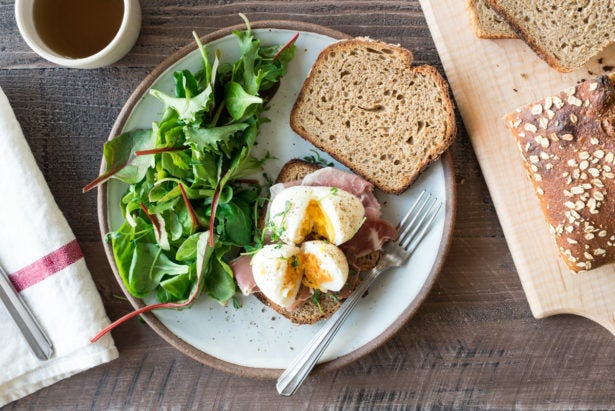
This bread, and its distinctive square slices reminiscent of its forebears, provides the perfect companion to a hearty egg breakfast, a blank canvas for peanut butter and jelly sandwiches, and is sure to be an all-around favorite of kids (with or without the crust, as kids do). The intentionally tight, but not heavy, crumb is perfect for holding piled-high ingredients and the thin, crunchy crust adds structure and bite.
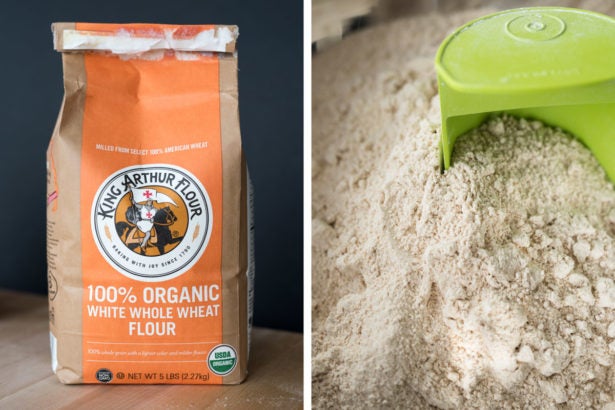
Golden whole wheat flour lends its wonderful qualities to this sandwich loaf. This whole-grain flour has a mild, almost sweet flavor profile compared to its more commonly used sibling, red-wheat flour (white and red refer to the color of the actual wheat berry).
This alternative whole wheat produces a wonderfully tender crumb and thin crust that still toasts up crunchy in all the right places. Further, this versatile bread becomes the perfect platform for creatively using what might be lying around in your pantry: seeds and grains as toppings, nuts and dried fruit as mix-ins, and even the substitution of other flours and grains for a portion of this recipe.
One reason I love to bake sourdough in a pan is the pan itself: the rigid structure means it’s possible to push the dough hydration relatively high without the risk of excessive spreading in the oven. Higher hydration dough can be challenging, but the resulting soft and creamy interior is worth the effort. Thanks to this additional structure provided by the pan, the final shape doesn’t even have to be perfect, it just needs to end up in the pan!
Baker's note: I developed this recipe by weight, using grams. For best accuracy, weigh your ingredients. If you measure by volume, understand your results may be slightly different, due to an unavoidable lack of precision in converting gram weights to volume.
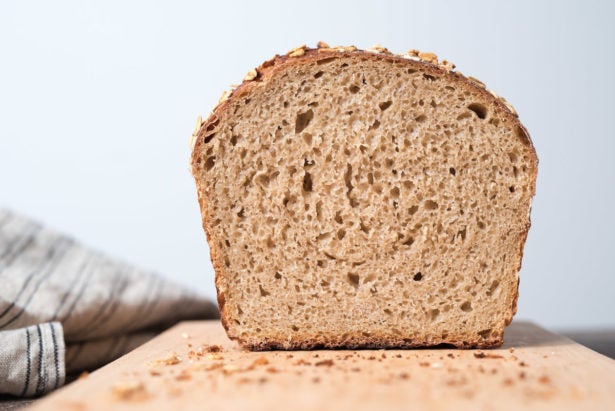
This recipe makes two 1,200g (generous 2 1/2-pound) loaves, each baked in a 9" x 5" loaf pan — a Pullman (pain de mie) pan without the lid will work equally well. You can halve this recipe to make only a single loaf but it's best to still make the levain, with specified quantities, as described below.
The levain calls for active, mature (a.k.a. ripe) sourdough starter. So if you don't feed your starter every day on a regular basis, take it out of the fridge and feed it at least twice, once in the morning and once at night, before using it. If it's been refrigerated without feeding for awhile, you may need to give it several feedings over several days to bring it up to strength. Your goal is a starter that doubles in size and looks quite active.
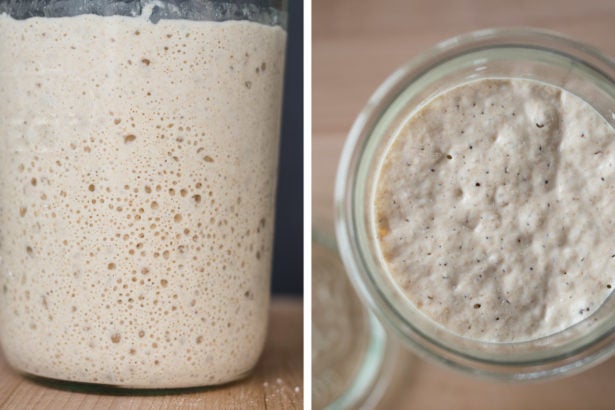
The night before mixing the dough, prepare the levain, using an active, mature sourdough starter. Mix together in a small container:
1/4 cup (30g) King Arthur Golden Whole Wheat Flour
1/4 cup (30g) King Arthur Unbleached Bread Flour
1/4 cup + 3/4 teaspoon (60g) water, around 90°F*
1/4 cup + 3/4 teaspoon (60g) mature (ripe, fed, active) sourdough starter
*If your kitchen is cold, use warmer water (up to 90ºF) to help the levain stay warm through the night.
Keep the levain somewhere warm, around 75ºF, for about 10 to 12 hours.
The goal will be to use this levain when it’s mature in the morning. It will be incorporated into the dough after the “autolyse” step below (which takes 2 hours). So when you wake in the morning, give yourself enough time to prepare the dough that it has time to rest for 2 hours before the levain is ready for use.
This recipe uses an autolyse technique that allows the mixed flour and water (no levain or salt) time to rest after incorporation. This resting period activates enzymes in the flour, giving them time to break down complex sugars into simple sugars. These sugars are then more available for use during fermentation, which ultimately leads to more flavorful, better-colored bread.
Place the following in a mixing bowl and mix by hand until all the dry bits are incorporated:
6 1/4 cups (705g) King Arthur Golden Whole Wheat Flour
3 1/3 cups (400g) King Arthur Unbleached Bread Flour
generous 1/2 cup (61g) whole rye flour (pumpernickel)
1 1/2 teaspoons (4g) diastatic malt (optional)
4 cups + 2 tablespoons (935g) water, around 90°F*
*The final target dough temperature for this bread should be 77ºF to 78ºF. If your kitchen is cold, use water up to 90°F in the mix to adjust the temperature of the dough to help reach this target.
Cover the mixing bowl and let the dough rest for 2 hours at room temperature.
Keep an eye on your levain at this point; if it looks like it’s maturing faster than expected, proceed to the next step by skipping the remainder of the autolyse time.
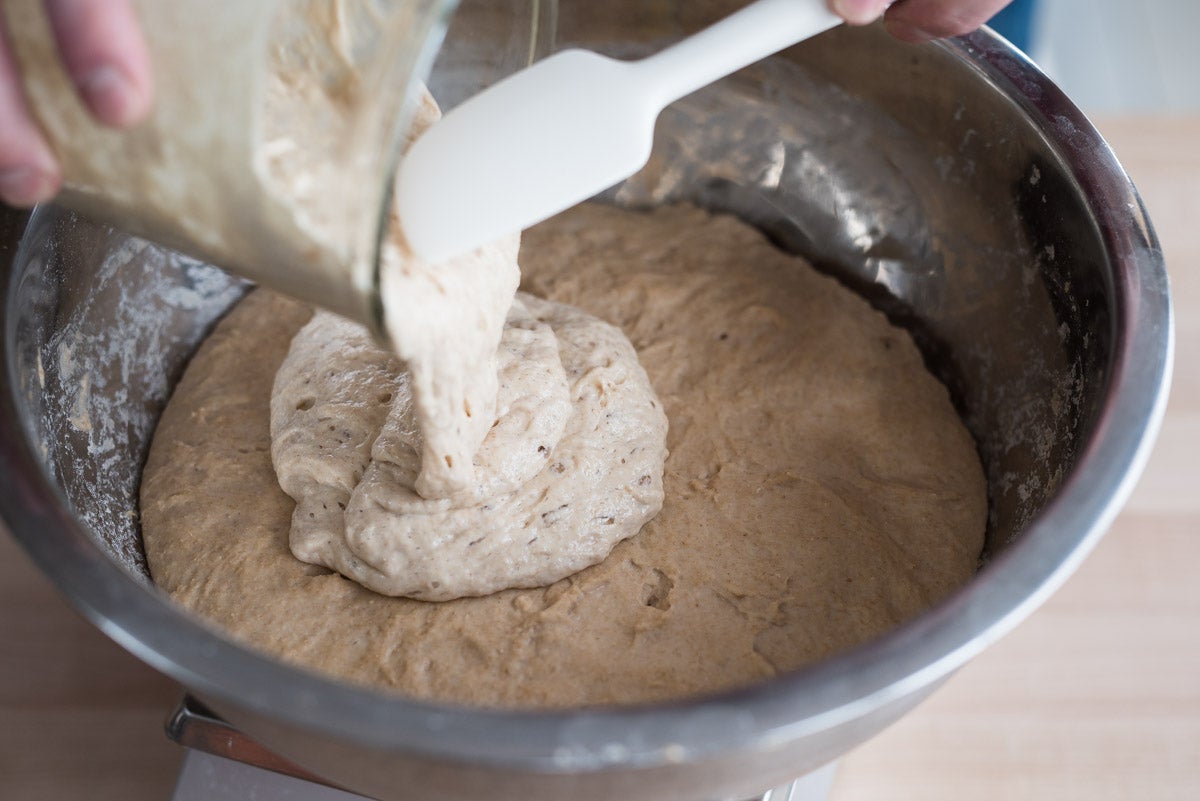
After the 2-hour autolyse, and when the levain is mature, add 5 teaspoons salt and the levain to the dough, and mix and knead by hand to make a tacky, soft dough that's starting to show signs of rounding into a ball. If you'd like to use a stand mixer, mix for 1 minute at the lowest speed ("stir" on a KitchenAid), and 2 minutes at the next speed up (speed 2 on a KitchenAid).
If you're kneading by hand, the dough should start to become smooth, but will remain a little sticky. If you're using a mixer, the dough will be smoother and start to cling to the hook, though it still may stick to the sides of the bowl here and there.
Transfer the dough to a tub or thick-walled bowl for bulk fermentation.
The dough is going to ferment (rise) for 3 1/2 hours, preferably at an ambient temperature of about 78°F. You're also going to stretch and fold the dough three times, spaced 30 minutes apart — so don't just cover it and leave the house!
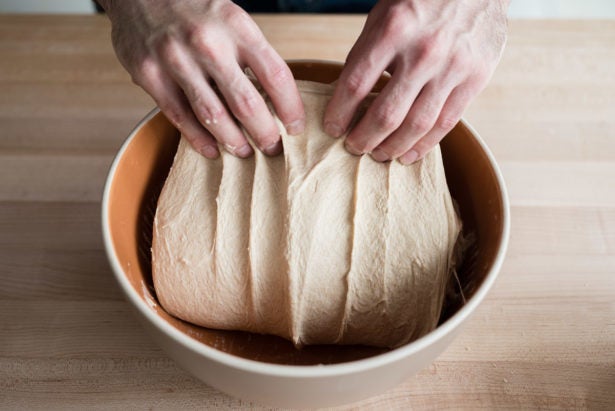
Do the first of your three stretch-and-folds 30 minutes into the dough's fermentation. For each set, stretch the north side up and fold over to just short of the south side (see above). Repeat for the south, east, and west sides for a total of four folds.
After you've done three sets of stretch-and-folds, spaced 30 minutes apart, let the dough rest undisturbed for an additional 2 hours, for a total of 3 1/2 hours.
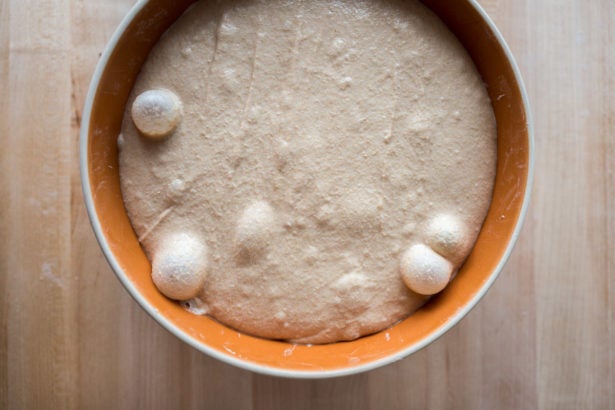
The dough should look something like this. You can see it's risen significantly. There are some bubbles on top and just below the surface; and most importantly, the edge where the dough meets the bowl is domed, convex. The dough should jiggle when the bowl is shaken; it should look active. These are good signs the dough is strong enough and ready to be divided.
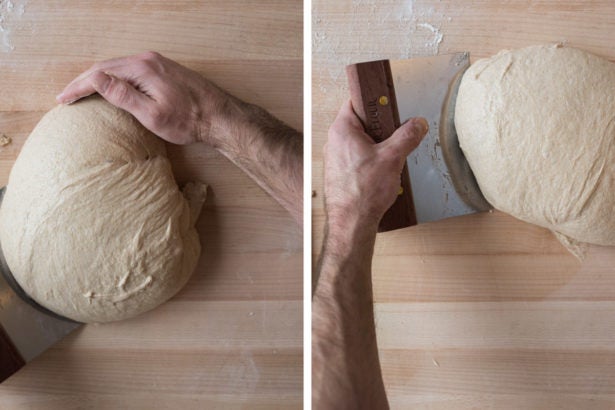
Dump the dough from the bulk container onto a lightly floured (or lightly greased) work surface. It will be sticky and a little slack; rely on a bench knife and a floured hand to gently divide the mass into two halves. Pre-shape each into a fairly taut round.
Let the pre-shaped dough rest 25 minutes, uncovered. During this time, prepare two 9" x 5" loaf pans by lightly oiling them with olive oil.
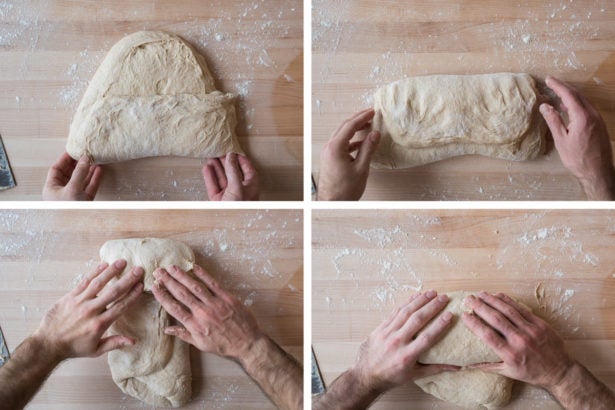
Sparingly flour the work surface and the top of each resting round; you want to use only enough flour that the dough doesn't stick to the surface. If you don't have to use any flour to prevent sticking, so much the better.
Using your hands and a bench knife, flip one round over and fold the top half up and over to the middle, and the bottom half up and over the just-folded top. You’ll have a long horizontal rectangle sitting in front of you.
Turn the rectangle 90 degrees and grab a small portion of the top. Pull it up and fold it over a little bit, pressing down to seal. Take the rolled top and continue to gently roll it downward toward your body, your two hands working together. As you do each roll and work your way down the vertical rectangle, use your thumbs to gently press the dough into itself (see above).
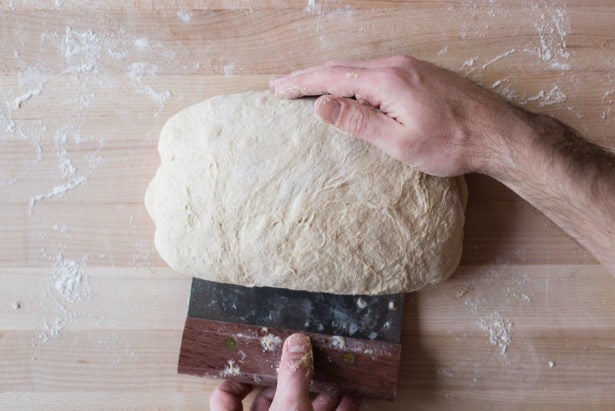
Once rolled up, transfer the shaped dough to a prepared pan. If you weren't able to shape the dough tight enough to cleanly drop it into the pan, use slightly wet hands to tuck the sides and top into the pan so the top of the dough is fairly taut.
If desired, spritz the loaf with warm water and top with rolled oats. Cover the pan with plastic. Repeat with the second piece of dough. Let the covered pans rest at room temperature for 1 hour before placing them into the refrigerator.
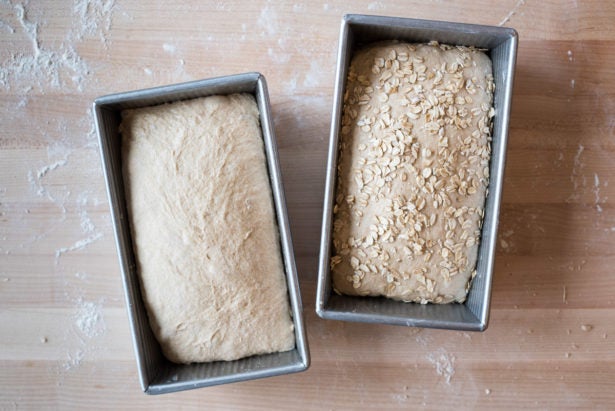
Let the dough proof (rise) overnight in the fridge, for 14 to 18 hours. The sooner the dough is baked the higher the rise, but less tender the interior. I like to push this proof to 18 hours for a superbly soft crumb.
Preheat your oven for 1 hour at 500ºF.
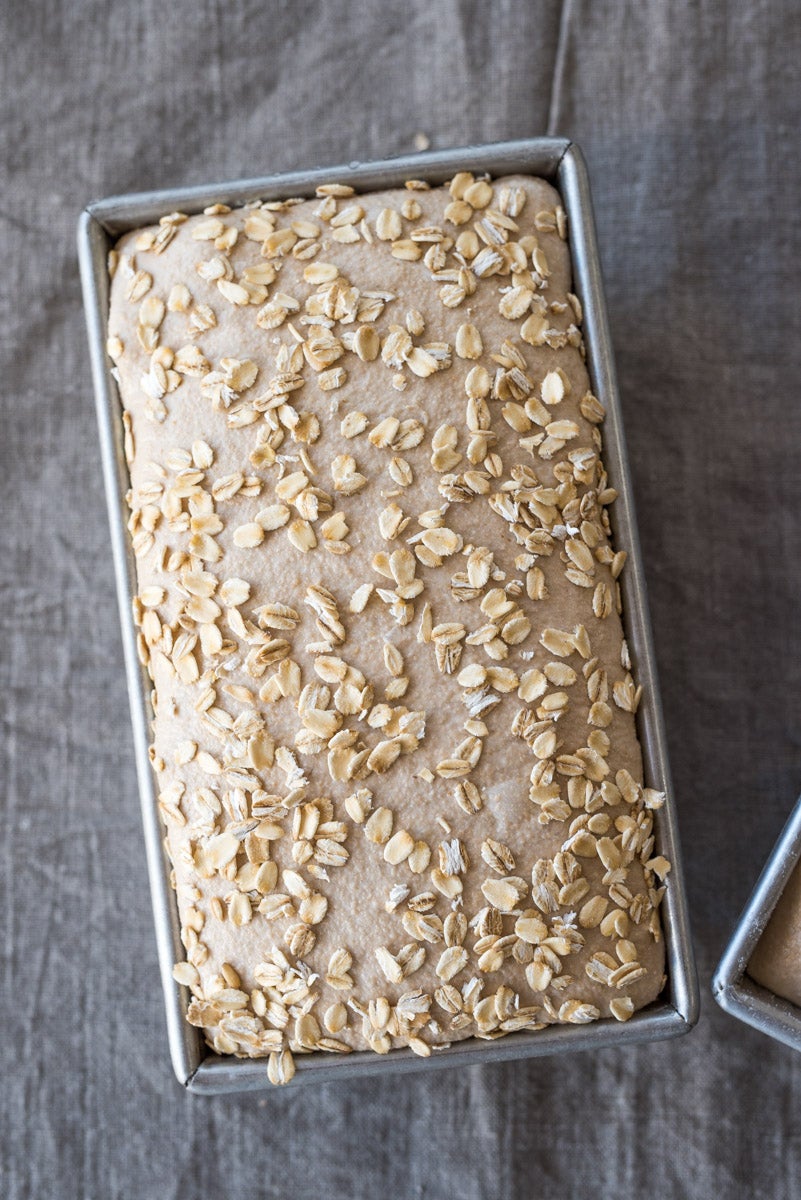
Remove both pans from the refrigerator. The dough should be well risen and either at, or close to, the rim of the pan. Uncover each loaf, spritz them with warm water, and place in the oven.
This bread does well with a lot of steam. You can place a cast iron frying pan in the bottom of the oven while it's preheating, then add 1 1/2 cups boiling water to the pan at the same time you place the bread in the oven.
Turn the oven down to 475ºF and bake for 20 minutes (use a handheld mister to spritz inside your oven and on the top of the dough, if you aren't using the cast iron pan method). After 20 minutes, turn the oven down to 450ºF and bake for an additional 20 minutes. Finally, turn the oven down to 425ºF and bake for 10 to 20 minutes, for a total of 50 to 60 minutes, or until the loaves test done. To ensure a full and complete bake, the exterior should be well colored and the interior temperature of each loaf should reach at least 200ºF, and potentially up to 208°F to 210°F.
Remove the loaves from the oven, and turn them out of the pans onto a rack. Cool for 1 to 2 hours before slicing.
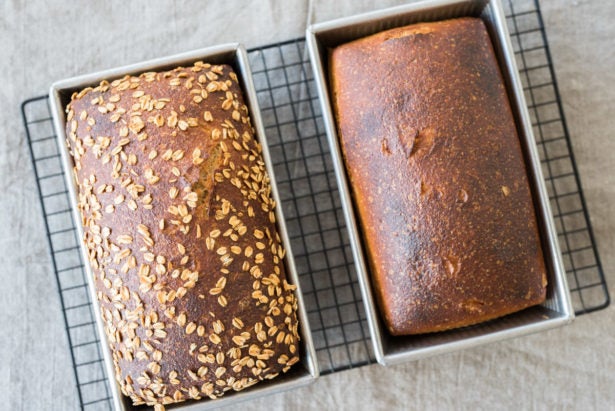
This versatile recipe is just a starting point for further experimentation and variety with other toppings, fruit additions, and flour choices.
Happy baking!
See the recipe for Multigrain Sourdough Sandwich Bread.